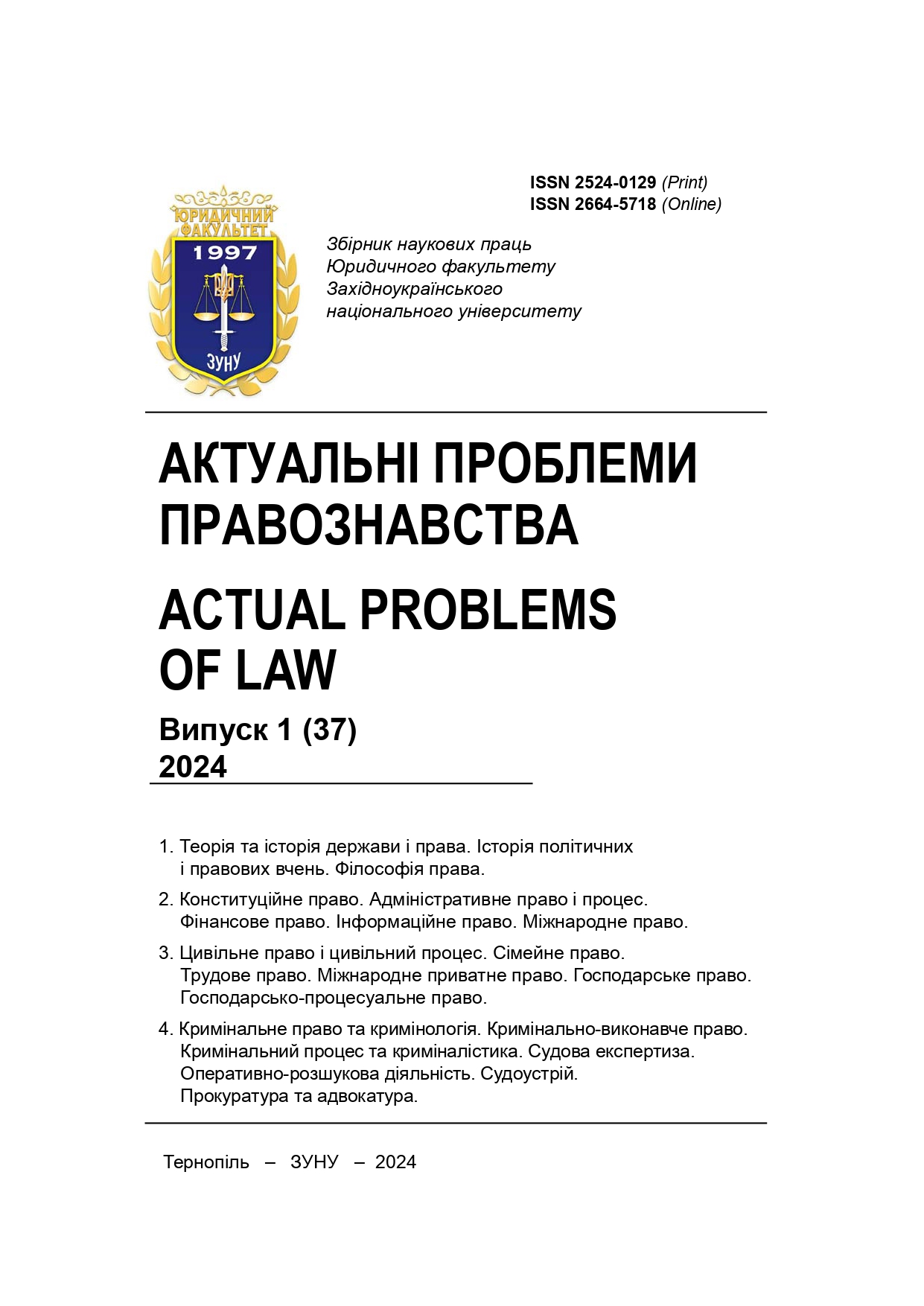The paradigm of copyright development in the United States of America
DOI:
https://doi.org/10.35774/app2024.01.286Keywords:
copyright, intellectual property, United States of America, Copyright Act (1976), Berne Convention for the Protection of Literary and Artistic WorksAbstract
This article focuses on the paradigm of copyright law development in the United States of America, with a particular emphasis on the various theoretical rationales and influences that have shaped its development. The emphasis is placed on the utilitarian nature of the American approach to copyright, which reflects the desire to maximize overall utility and economic rights, as opposed to European traditions that focus on the author's non-property rights. The article analyzes the main philosophical foundations on which US intellectual property law is based, including Bentham's utilitarianism, Locke's theory of the wasteland of labor, and Hegel's theory of personal rights.
Particular attention is paid to the analysis of the absence of the concept of non-property rights in American law, which has long been an obstacle to the US accession to the Berne Convention for the Protection of Literary and Artistic Works. Despite ratifying this Convention in 1989, the United States has avoided implementing the provisions on moral rights, believing that current legislation sufficiently meets the requirements of the Convention. The article provides a theoretical analysis of the criticism of this position by both American and Ukrainian scholars.
The author characterizes the impact of the Berne Convention on American copyright law, emphasizing the difficulties associated with the implementation of moral rights. The article highlights the main provisions of the Copyright Act of 1976, in particular, the requirements for the originality of works, the criteria for their fixation in a tangible form and the list of categories subject to protection. The article emphasizes that although copyright protection is focused on the economic remuneration of creators, it also contributes to the common good by enriching the cultural context.
References
Boiarchuk, O. M. (2023). Zakhyst prava intelektu-alnoi vlasnosti: osoblyvosti zdiisnennia v Ukraini, SShA ta deiakykh krainakh Yevropeiskoho soiuzu (Nimechchyna, Frantsiia) [Protection of Intellectual Property Rights: Peculiarities of Implementation in Ukraine, the United States and Some European Union Countries (Germany, France)]. Elektronne naukove vydannia «Analitychno-porivnialne pravoznavstvo» - Electronic scientific publication «Analytical and Comparative Jurisprudence», 6, 184-188. Retrieved from http://journal-app.uzhnu.edu.ua/article/view/294411 [in Ukrainian]
Konstytutsiia Spoluchenykh Shtativ Ameryky. Filadelfiiskyi konvent vid 17 veresnia 1787 r. [The Constitution of the United States of America. The Philadelphia Convention of September 17, 1787]. Retrieved from https://www.whitehouse.gov/about-the-white-house/ourgovernment/the-constitution/ [in English]
Lopatin, M. D. (2022). Zakhyst prav intelektualnoi vlasnosti v SShA ta Ukraini Protection of intellectual property rights in the United States and Ukrain]: mizhn. nauk.-prakt. konf. «Yevraziy̆ski naukovi dyskusiï» - «Eurasian scientific discussions», Barselona, 13-15 liutoho 2022 r., 569–573 in Ukrainian]
Yakubivska, Yu. Ye. (2015). Implementatsiia mizhnarodnykh norm u sferi intelektualnoi vlasnosti v natsionalnu praktyku v konteksti pidvyshchennia efektyvnosti instytutsiinoho seredovyshcha [Implementation of international intellectual property norms into national practice in the context of improving the efficiency of the institutional environment. Efektyvna ekonomika - Efficient economy, 10. Dnipropetrovsk: DDATU. Retrieved from http://www.economy.nayka.com.ua/?op=1&z=4430 [in Ukrainian]
Adler, A. (2009). Against moral rights. Calif Law Rev., 97, 263–301. Retrieved from https://papers.ssrn.com/sol3/papers.cfm?abstract_id=1365437 [English]
Aoki, K. (2006). Distributive and syncretic motives in intellectual property law (with special reference to coercion, agency, and development. UC Davis Law. Rev., 40, 717–801. Retrieved from https://lawreview.law.ucdavis.edu/archives/40/3/distributive-and-syncretic-motives-intellectual-property-law-special-reference [in English]
Berne Convention for the Protection of Literary and Artistic Works (as amended on September 28, 1979). WIPO. Retrieved from: https://www.wipo.int/wipolex/en/text/283698 [in English]
Berne Implementation Act of 1988. Pub. L. No. 100–568. 102 Stat. 2853 Sec. 13(a) (1988). Retrieved from https://www.congress.gov/bill/100th-congress/house-bill/4262 [in English]
Bouchoux, D. (2012). Intellectual property: the law of trademarks, copyrights, patents, and trade secrets, 4th edn. Cengage Learning, Delmar. Retrieved from https://mitmecsept.wordpress.com/wp-content/uploads/2018/10/deborah_e-_bouchoux_intellectual_property_the_lbookzz-org.pdf [in English]
Bracha, O. (2008). The ideology of authorship revisited: authors, markets, and liberal values in early American copyright. Yale Law, 118, 186–271. Retrieved from https://doi.org/10.2307/20454710 [in English]
Case details for Morly Investments Pty Ltd (imprint: The High Street Publishing Company) v. The Walt Disney Company, et al. Copyright Claims Board. 2024. Retrieved from https://dockets.ccb.gov/case/detail/22-CCB-0015 [in English]
Copyright Act of 1976. Free Speech Center. Retrieved from https://firstamendment.mtsu.edu/article/copyright-act-of-1976/#:~:text=Harmonizing%20copyright%20law%20with%20free,35%20years%20after%20their%20transfer [in English]
Evolution, Inc. v. Suntrust Bank. 342 F. Supp 2d 943. 956 (D. Kan 2004). Justia US. Retrieved from https://law.justia.com/cases/federal/district-courts/FSupp2/342/964/2380276/ [in English]
Feist Publications, Inc. v. Rural Telephone Service Company, Inc. 111 S.Ct. 1282 (1991), 1294. CaseBrief. Retrieved from https://www.casebriefs.com/blog/law/property/property-law-keyed-to-singer/intellectual-property/feist-v-rural-telephone-service-co/ [in English]
Hutukka, P. (2023). Copyright Law in the European Union, the United States and China. Springer. IIC, 54, 1044–1080. Retrieved from https://doi.org/10.1007/s40319-023-01357-0 [in English]
Jaszi, P. (1991). Toward a theory of copyright: the metamorphoses of authorship. Duke Law J, 2, 455–502. Retrieved from https://scholarship.law.duke.edu/cgi/viewcontent.cgi?article=3150&context=dlj [in English]
Kelly v. Arriba Soft Corp. 336 F. 3d 811. 9th Cir. 2003. Retrieved from https://www.copyright.gov/fair-use/summaries/kelly-arriba-9thcir2003.pdf [in English]
McJohn, S. (2019). Intellectual property, 6th edn. Wolters Kluwer. New York. [in English]
Nichols v. Universal Pictures Corp. 45 F.2d 119. 2d Cir.1930. Justia US Law. Retrieved from: https://law.justia.com/cases/federal/appellate-courts/F2/45/119/1489834/ [in English]
Samuelson, P. (1993). Fair use for computer programs and other copyrightable works in digital form: the implications of Sony, Galoob and Sega. J Intellect Prop Law, 149–118. Retrieved from https://digitalcommons.law.uga.edu/jipl/vol1/iss1/6 [in English]
Samuelson, P. (2016). Reconceptualizing copyright’s merger doctrine. J Copyr Soc USA, 63, 417–470. Retrieved from https://lawcat.berkeley.edu/record/1127790 [in English]
Sega Enterprises Ltd. v. Accolade, Inc. 977 F.2d 1510. 9th Circ. 1992. Retrieved from https://www.copyright.gov/fair-use/summaries/segaenters-accolade-9thcir1992.pdf [in English]
The Authors Guild, Inc. v. Google, Inc. 954 F. Supp 2d 282. S.D.N.Y. (2015). Justia US Law. Retrieved from https://law.justia.com/cases/federal/appellate-courts/ca2/13-4829/13-4829-2015-10-16.html [in English]





